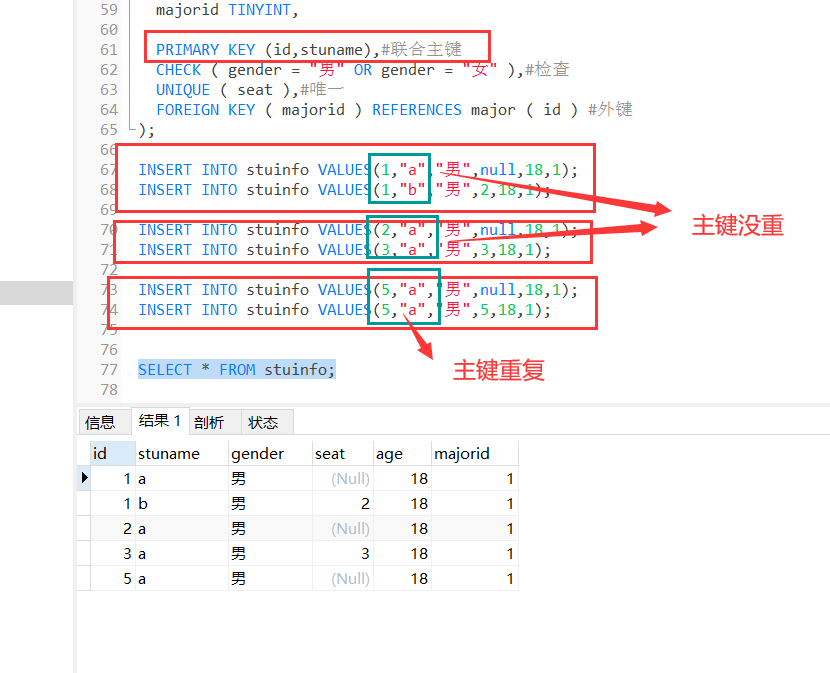1, Common field type classification
| type | classification | describe |
|---|---|---|
| Numerical type | integer | |
| decimal | ① Fixed point number ② Floating point number | |
| character | Shorter text | ①char ②varchar |
| Long text | ①text ② Blob (binary data) | |
| Date time type | ||
1.1 numerical type
1.1.1 integer
characteristic:
- The integer type is signed by default. If you want to set it to unsigned, you need to add it after the integer type UNSIGNED
- If the inserted value exceeds the integer range, an error will be reported (out of range), and the inserted value is a critical value (see the database version for details)
- If the length is not set, there will be a default length
| Integer type | byte | Signed and unsigned representations | Range |
|---|---|---|---|
| Tinyint | 1 | Signed Tinyint | -128~127 |
| Unsigned Tinyint UNSIGNED | 0~255 | ||
| Smallint | 2 | Signed Smallint | -32768 ~ 32767 |
| Unsigned Smallint UNSIGNED | 0~65535 | ||
| Mediumint | 3 | Signed Mediumint | -8388608 ~ 8388607 |
| Unsigned Mediumint UNSIGNED | 0 ~ 1677215 | ||
| Int integer | 4 | Signed Int | -2147483648 ~ 2147483647 |
| Unsigned Int UNSIGNED | 0~ 4294967295 | ||
| Bigint | 8 | Signed Bigint | -9223372036854775808~9223372036854775807 |
| Unsigned Bigint UNSIGNED | 0 ~ 2**64-1 |
1.1.1.1 set unsigned and signed for integer fields
Syntax: integer type unsigned For example: INT UNSIGNED
1.1.1.2 meaning of field type length
Description: when creating a table, the length of the field is usually set when setting the field type. The length here does not refer to the representation range of the value of the field. The representation range of the field is determined by the type of the field. The length here actually refers to the display width of the data, that is, when the width is not enough, 0 will be added to the left of the value.
For example: field type (length) ZEROFILL
Note: ZEROFILL automatically converts numeric values to unsigned integers
As follows:
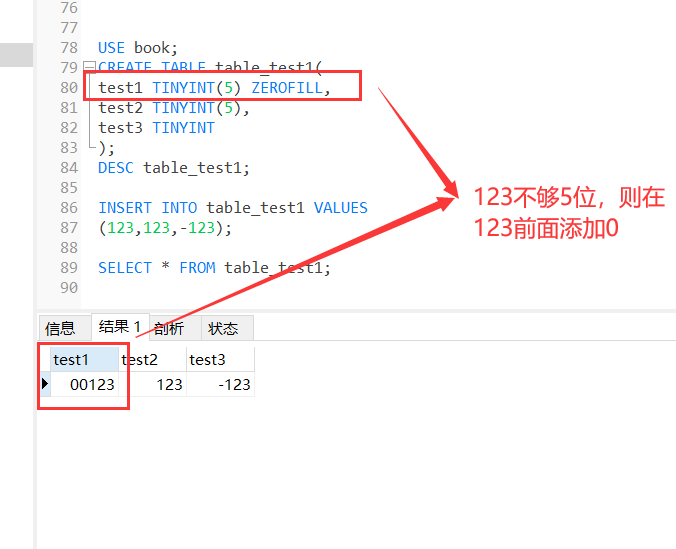
1.1.2 decimals
characteristic:
- M represents : Integer part + decimal part
- D means decimal position
- When out of range (when integer part length > M-D ), The specific error warning depends on the specific version mysql8 version is When integer part length > M-D Will report an error
- Both M and D can be omitted. If decimal omits m and D, m defaults to 10 and D defaults to 0, that is, only integer parts will be retained; float and double determine the accuracy according to the range
- The precision of fixed-point type is high. If the precision of the inserted value is required to be high, the fixed-point type, such as currency operation, is used
1.1.2.1 floating point number type
| Floating Point Types | byte | Range |
|---|---|---|
| float(M,D) | 4 | ±1.75494321E-38 ~ ±3.402823466E+38 |
| double(M,D) | 8 | ±2.2250738585072014E-308 ~ ±1.7976931348623157E+308 |
1.1.2.2 fixed point number type (higher precision)
characteristic:
| Fixed point number type | byte | Range |
|---|---|---|
| DEC(M,D) decimal(M,D) | M+2 | The maximum value range is the same as double, and the effective value range of a given decimal is determined by M and D |
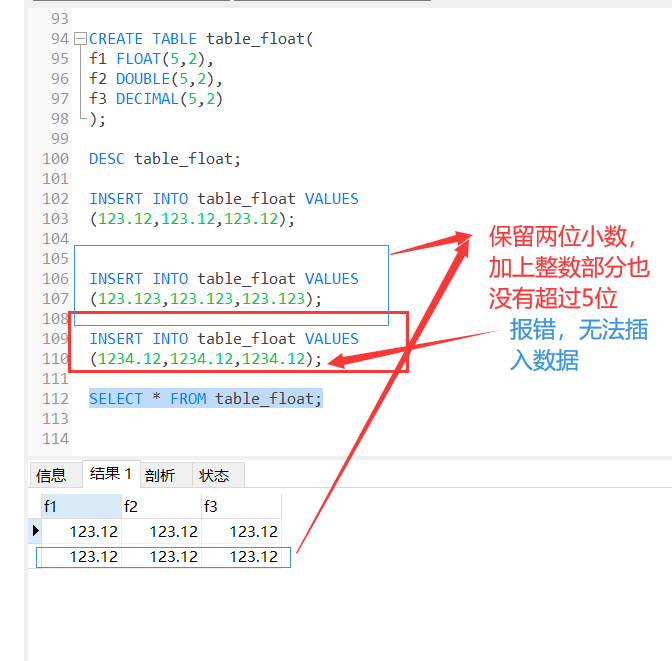
1.2 character type
1.2.1 short text
| Character type | Maximum number of characters | describe | characteristic | Space utilization | Time efficiency |
|---|---|---|---|---|---|
| char(M) | M M can be omitted and is 1 by default | M is an integer between 0 and 255 | Fixed length characters | It consumes more space, and the space utilization rate is low | high |
| varchar(M) | M M cannot be omitted | M is an integer between 0 and 65535 | Variable length characters | It saves space and has high space utilization | low |
1.2.1.1 char
1.2.1.2 varchar
1.2.2 long text
1.2.2.1 text
1.2.2.2 blob
1.2.3 other strings
| Character type | classification | describe |
|---|---|---|
| Binary string | binary Save a shorter binary string | Similar to char and varchar, the difference is binary. Varbinary only contains binary strings and does not contain non binary strings |
| varbinary Save long binary string | ||
| enum type | Specific usage example 1 | Also known as enumeration type The value required to be inserted must belong to one of the values specified in the list For example, if the list member is 1 ~ 255, only 1 byte storage is required |
| set type | Specific usage example 2 | Similar to enum type, it can hold 0 ~ 64 members The biggest difference between set type and enum type is that set type can select multiple members at a time, while enum type can only select one member Depending on the number of members, the bytes occupied by storage are also different |
Example 1:
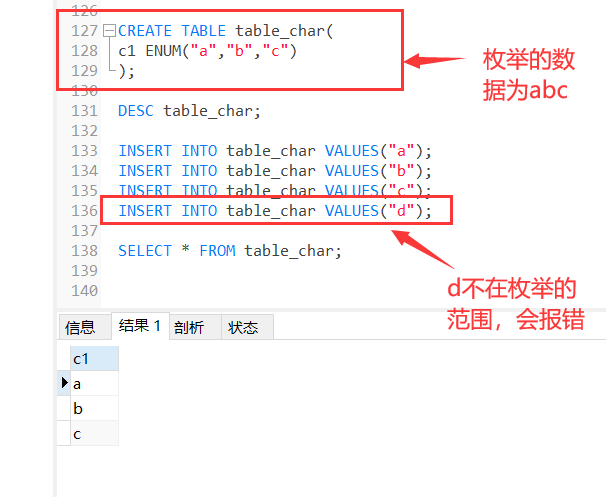
Example 2:
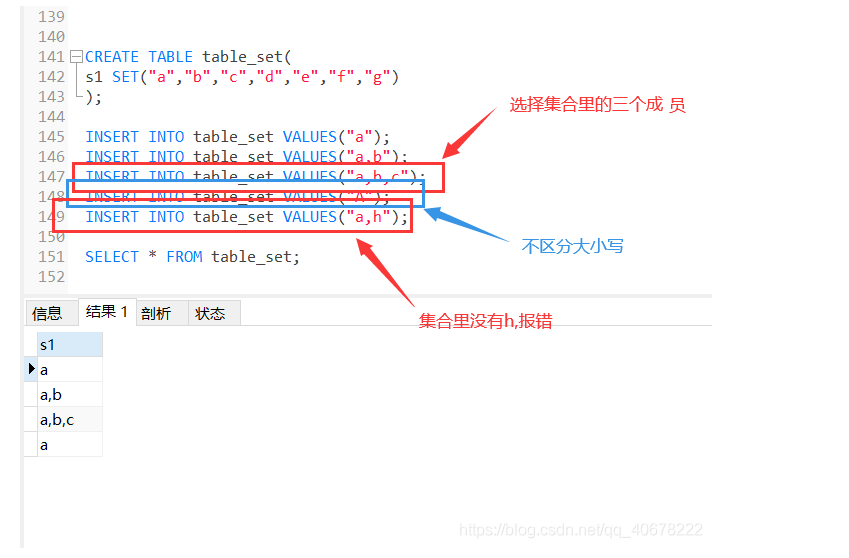
one point three Date time type
| Date time type | byte | minimum value | Maximum |
|---|---|---|---|
| date | 4 | 1000-01-01 | 9999-12-31 |
| datatime | 8 | 1000-01-01 00:00:00 | 9999-12-31 23:59:59 |
| timestamp | 4 | 19700101080001 | Sometime in 2038 |
| time | 3 | -838:59:59 | 838:59:59 |
| year | 1 | 1901 | 2155 |
The difference between datetime and timestamp
-
Timestamp supports a small time range, with a value range of 1970011080001 To 2038 A time of year; value range of Datetime: 1000-1-1 to 9999- 12-31
-
timestamp is related to the actual time zone and can better reflect the actual date, while datetime can only reflect the local time zone at the time of insertion For example: Example 1
-
The timestamp attribute is greatly affected by the version of Mysq and SQLMode
Example 1:
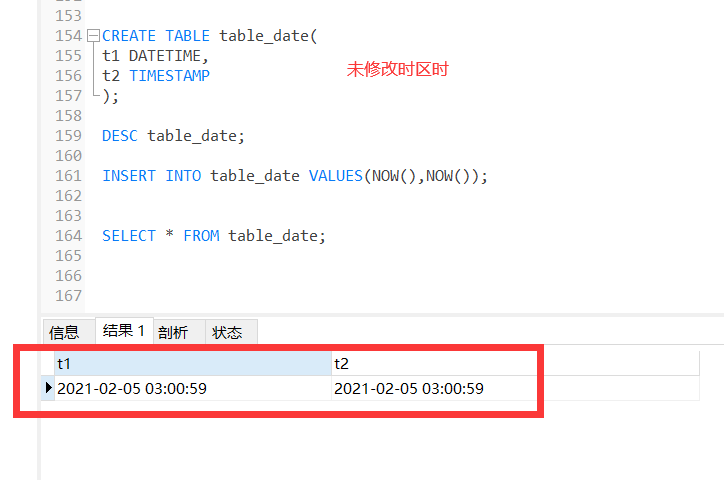
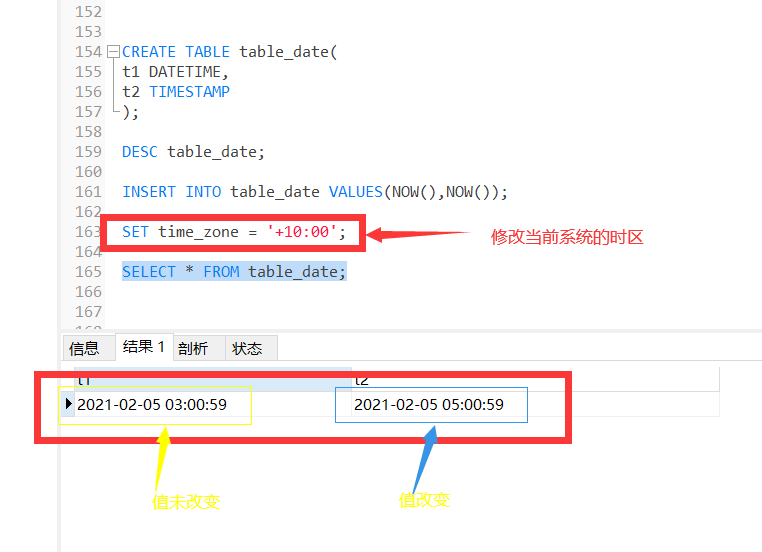
2, Constraint type
Description: a constraint condition when creating a table structure. It is used to limit the data in the table. The purpose is to ensure the reliability and accuracy of inserted data
Classification (six constraints):
- NOT NULL: non NULL, used to ensure that the value of this field cannot be NULL
- DEFAULT: DEFAULT, used to ensure that the field has a DEFAULT value
- PRIMARY KEY: primary KEY, used to ensure that the value of this field is unique and non empty
- UNIQUE: UNIQUE. It is used to ensure that the value of this field is UNIQUE. It can be blank
- CHECK: CHECK constraints [not supported in mysql]
- FOREIGN KEY: foreign KEY. It is used to restrict the relationship between two tables. It is used to ensure that the value of this field must come from the value of the associated column of the primary table. When adding a foreign KEY constraint from the secondary table, it is used to reference the value of a column in the primary table
When to add constraints:
- When creating a table
- When modifying a table
Add classification of constraints
- Column level (field) constraints: the six constraints are syntactically supported, but foreign key constraints have no effect
- Table level constraints: except non empty (NOT) NULL), default (DEFAULT), and others are supported
CREATE TABLE Table name( Field name field type column level constraint, Field name field type column level constraint, ... Field name field type column level constraint, Table level constraints );
The unique difference between primary key and primary key:
| Constraint type | Guarantee uniqueness | Allow null | Are there multiple | Allow combination (Union key) |
|---|---|---|---|---|
| Primary key PRIMARY KEY | √ | × | There can be at most one primary key field | Yes (but not recommended) |
| only UNIQUE | √ | √ | There can be multiple unique fields | Yes (but not recommended) |
2.1 column level constraints
Syntax:
CREATE TABLE Table name( Field name field type column level constraint column level constraint column level constraint..., Field name field type column level constraint column level constraint column level constraint..., ... Field name field type column level constraint column level constraint column level constraint..., );
Note:
- Only non empty, default, unique and primary key are supported
- A field can have multiple constraints
Example 1:
CREATE TABLE stuinfo( id INT PRIMARY KEY, #Primary key stuname VARCHAR(20) NOT NULL,#Non empty gender CHAR(1) CHECK(gender="male" OR gender="female"),#inspect seat INT UNIQUE,#only age TINYINT DEFAULT 18,#default majorid TINYINT REFERENCES major(id) #Foreign key ); CREATE TABLE major( id TINYINT PRIMARY KEY,#Primary key majorname VARCHAR(20) );
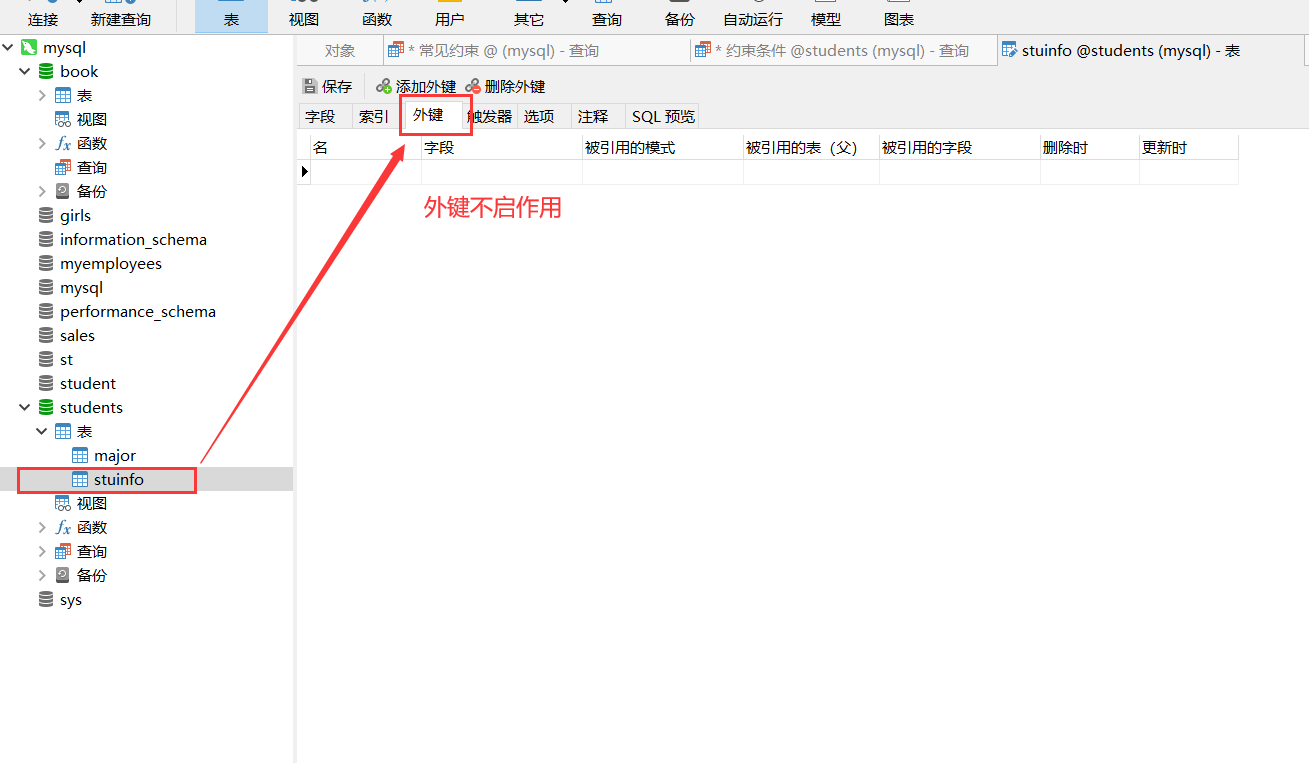
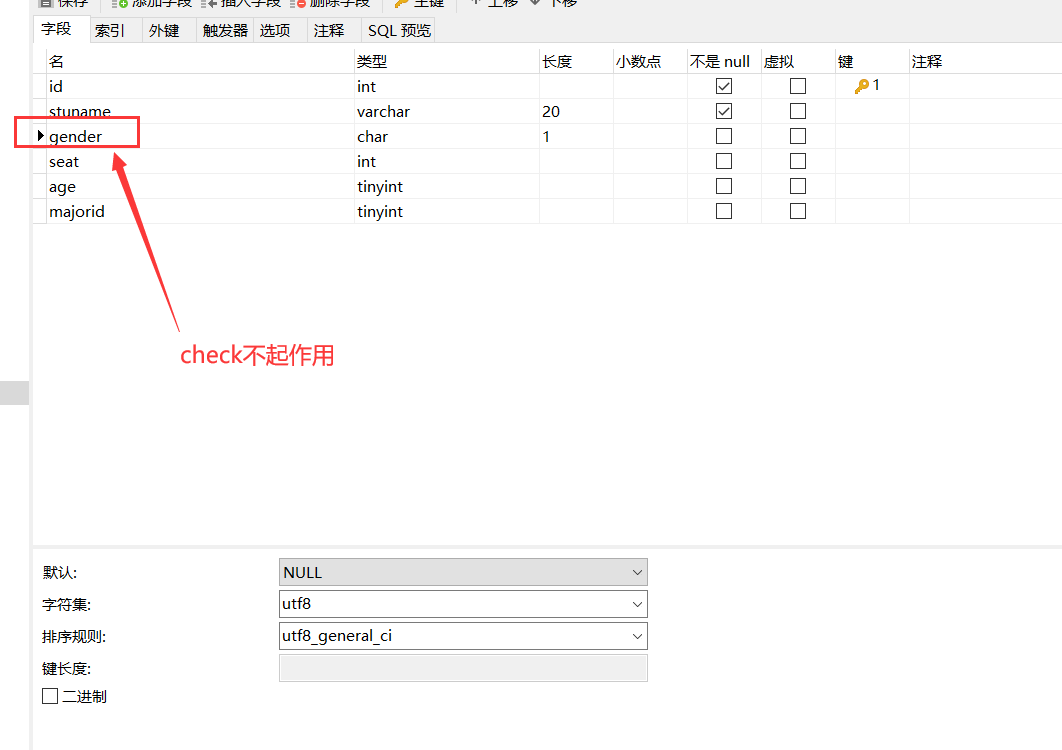
2.2 table level constraints
Syntax:
CREATE TABLE Table name( Field name field type, Field name field type, ... Field name field type, [CONSTRAINT Constraint name] constraint type(Field name), [CONSTRAINT Constraint name] constraint type(Field name), ... [CONSTRAINT Constraint name] constraint type(Field name), [CONSTRAINT Constraint name] FOREIGN KEY(Associated table name) REFERENCES Associated table name(Associated field name) #Foreign key );
Example 1:
CREATE TABLE stuinfo( id INT, stuname VARCHAR(20) NOT NULL,#Non empty gender CHAR(1), seat INT, age TINYINT DEFAULT 18, #default majorid TINYINT, CONSTRAINT pk PRIMARY KEY(id),#Primary key CONSTRAINT ck CHECK(gender="male" OR gender="female"),#inspect CONSTRAINT uq UNIQUE(seat),#only CONSTRAINT fk_stuinfo_major FOREIGN KEY(majorid) REFERENCES major(id) #Foreign key );
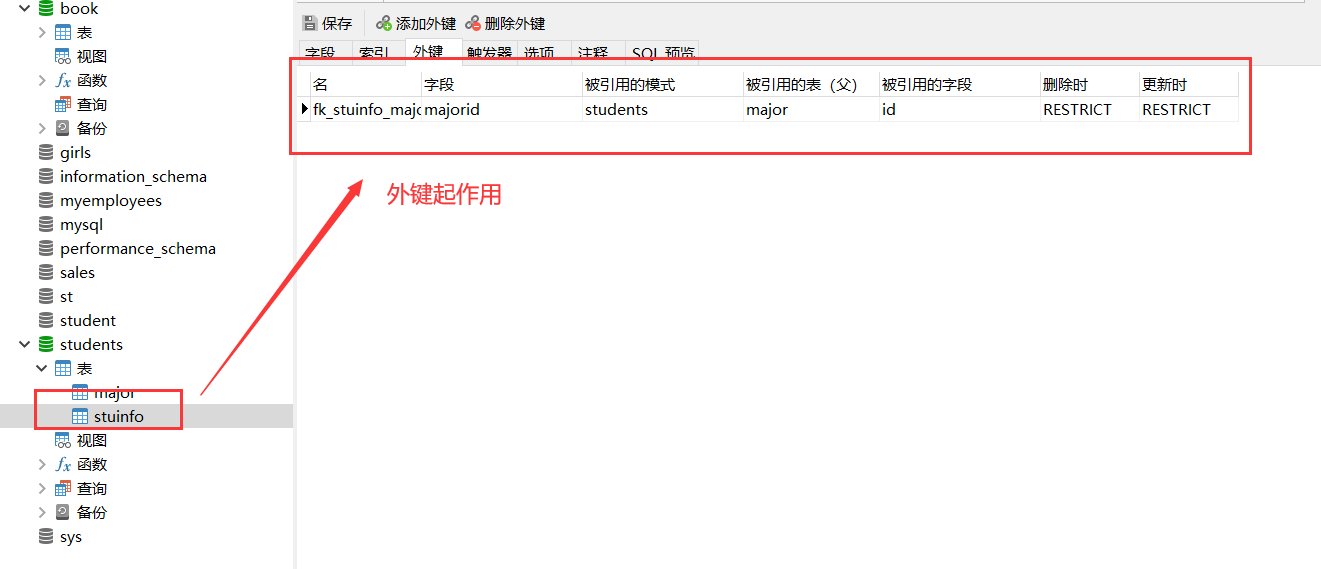
2.2.1 federated PK
Joint primary key: two or more fields form a primary key
CREATE TABLE stuinfo ( id INT, stuname VARCHAR ( 20 ) NOT NULL,#Non empty gender CHAR ( 1 ), seat INT, age TINYINT DEFAULT 18,#default majorid TINYINT, PRIMARY KEY (id,stuname),#composite keys CHECK ( gender = "male" OR gender = "female" ),#inspect UNIQUE ( seat ),#only FOREIGN KEY ( majorid ) REFERENCES major ( id ) #Foreign key );
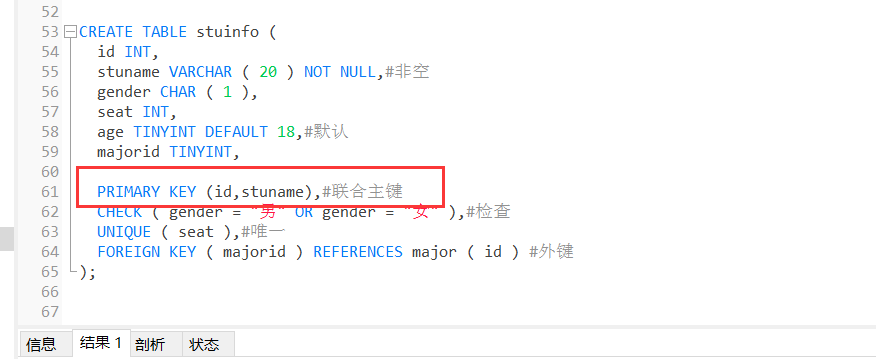

How to determine whether the primary key is duplicate
2.2.2 joint unique key
CREATE TABLE stuinfo ( id INT, stuname VARCHAR ( 20 ) NOT NULL,#Non empty gender CHAR ( 1 ), seat INT, age TINYINT DEFAULT 18,#default majorid TINYINT, PRIMARY KEY (id),#Primary key CHECK ( gender = "male" OR gender = "female" ),#inspect CONSTRAINT Union unique key UNIQUE (seat,stuname),#Union unique key FOREIGN KEY ( majorid ) REFERENCES major ( id ) #Foreign key );

2.2.3 foreign keys
characteristic:
- Requires a foreign key relationship to be set in the slave table
- The foreign key field type of the slave table should be consistent or compatible with the associated field type of the master table, but the foreign key field name of the slave table can be different from the associated field name of the master table
- The associated field of the main table must be a key (primary key or unique)
- When inserting data, insert the master table first and then the slave table
- When deleting data, delete the secondary table first, and then the primary table
2.3 adding constraint types when modifying tables
Syntax:
① Column level constraint
ALTER TABLE Table name MODIFY COLUMN Field name new constraint type;
For example: ALTER TABLE table name MODIFY COLUMN id PRIMARY KEY# Add primary key constraint
② Table level constraints
ALTER TABLE Table name ADD [CONSTRAINT Constraint name] constraint type(Field name);
For example: ALTER TABLE table name ADD PRIMARY KEY(id); # Add primary key constraint
2.3.1 adding non empty constraints
ALTER TABLE Table name MODIFY COLUMN Field name field type NOT NULL;
2.3.2 adding default constraints
ALTER TABLE Table name MODIFY COLUMN Field name field type DEFAULT Default value;
2.3.3 add primary key constraint
① Column level constraint
ALTER TABLE Table name MODIFY COLUMN Field name PRIMARY KEY;
② Table level constraints
ALTER TABLE Table name ADD [CONSTRAINT Constraint name] PRIMARY KEY(Field name);
2.3.4 adding unique constraints
① Column level constraint
ALTER TABLE Table name MODIFY COLUMN Field name Field type UNIQUE;
② Table level constraints
ALTER TABLE Table name ADD [CONSTRAINT Constraint name] UNIQUE(Field name);
2.3.5 adding foreign keys
ALTER TABLE Table name ADD [CONSTRAINT Constraint name] FOREIGN KEY (Main table name) REFERENCES Main table name( Associated field name );
2.4 deleting constraint types when modifying tables
2.4.1 delete non empty constraint
ALTER TABLE Table name MODIFY COLUMN Field name field type NULL;
2.4.2 delete default constraint
ALTER TABLE Table name MODIFY COLUMN Field name field type;
2.4.3 Delete primary key
ALTER TABLE Table name DROP PRIMARY KEY
2.4.4 delete unique key
ALTER TABLE Table name DROP INDEX Unique key field name;
2.4.5 deleting foreign keys
ALTER TABLE Table name DROP FOREIGN KEY Foreign key name
3, Cascade delete and cascade empty
three point one cascading deletion
When deleting a table with foreign keys, the related data of the slave table is generally deleted first, and then the related data of the primary table.
However, if you want to delete the related data of the primary table first, you can set a cascade relationship for the secondary table
Syntax 1:
Cascade deletion: when deleting the related data of the primary table, the corresponding data of the secondary table will also be deleted
ALTER TABLE From table name ADD CONSTRAINT Foreign key name FOREIGN KEY(Main table name) REFERENCES Main table name(Foreign key field) ON DELETE CASCADE;
3.2 cascade emptying
Cascade empty: when deleting the related data of the primary table, the corresponding data of the secondary table will not be deleted
ALTER TABLE From table name ADD CONSTRAINT Foreign key name FOREIGN KEY(Main table name) REFERENCES Main table name(Foreign key field) ON DELETE SET NULL;
